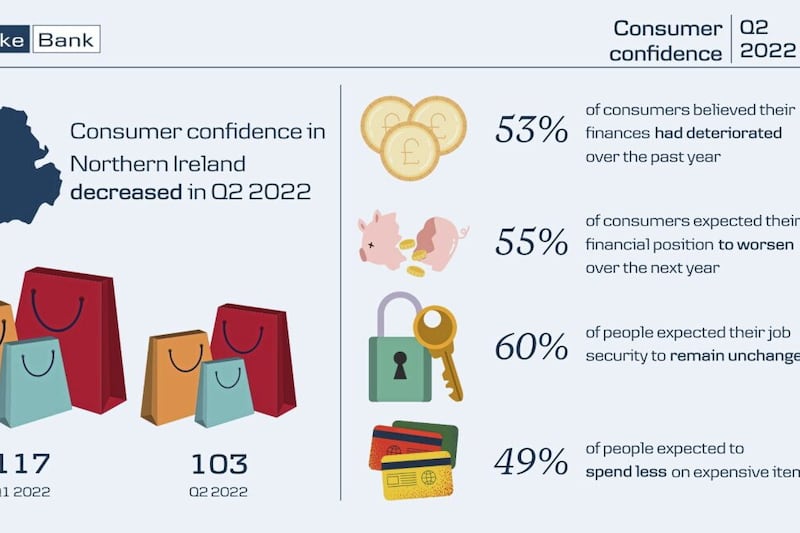DANSKE Bank latest Northern Ireland quarterly sectoral forecasts report, published today, estimates the rate of economic and jobs growth in 2019 and 2020,and it's a mixed picture.
Looking at the latest official economic data, it appears the local economy contracted in the third quarter of 2019. The Index of Services and Index of Production data, published before Christmas, showed that production output and services activity both declined between October and December, and we now estimate that, for 2019 as a whole, the Northern Ireland economy grew by just 0.8 per cent.
In 2020, the pace of economic growth is expected to rise slightly, but will remain modest at 0.9 per cent. From a sector viewpoint, the information and communication and professional services sectors are likely to be the two fastest growing parts of the local economy.
Regarding the labour market, we expect the annual rate of jobs growth in 2019 to come in at around 1.7 per cent, but are forecasting a slowdown in employment growth in 2020 to around 0.5 per cent.
But, what are the factors expected to drive the performance of the local economy? What impact will Brexit have? And what risks and uncertainties are out there?
Here are five things you need to know from our latest report:
1 Household spending growth looks set to remain solid
A simultaneous pick-up in wage growth and a moderation of inflationary pressures led to household spending power remaining relatively strong over the past year. Looking into 2020, inflation is likely to remain relatively low and the labour market is expected to remain in reasonably good health, leading to continued strong real wage growth. Therefore, household spending power should remain solid throughout the year. We expect growth in spending to track gains in real incomes over the next few years, with consumer spending in Northern Ireland estimated to have grown by 1.0 per cent in 2019 and forecast to rise by 0.9 per cent in 2020.
2 Brexit likely to continue having a negative impact on businesses
Following the outcome of the general election, the UK is now expected to leave the EU at the end of January 2020 and enter the transition period, during which trade between the UK and the EU will continue as it did previously. However, there is still a lack of clarity around the future, long-term, trading relationship between the UK and the EU, and around how trade between Northern Ireland and Great Britain will be affected by the updated Northern Ireland protocol included in the Brexit Withdrawal Agreement. Business investment is estimated to have had another weak year in 2019 and is forecast to remain subdued in 2020.
3 Slow global growth still a challenge
UK exporters have found life tougher of late, with the slowdown in global growth more than offsetting any gains from the weaker pound. Growth in world trade is expected to remain slow compared with 2018 as the impact of greater trade protectionism feeds through. This is likely to continue posing challenges for exporting businesses in Northern Ireland and across the rest of the UK.
4 Economic policy to be supportive of growth
With Brexit and slow global growth still expected to adversely impact the economy in 2020, we think that interest rates will remain at their current, accommodative, rate of 0.75 per cent throughout this year. At this stage, we don’t expect the pace of global economic growth or the uncertainty around Brexit to be sufficiently worse than last year to persuade the Monetary Policy Committee to vote for an interest rate cut.
A loosening of the fiscal stance was announced in last September’s Spending Round and, following the general election and the apparent public support for more government spending, the new Government will likely loosen fiscal policy more than its manifesto commitments imply. Overall, this means that the fiscal stance is expected to be modestly supportive of GDP growth in 2020.
5 The economy still faces several risks
Brexit remains a key risk to the Northern Ireland and UK economies in 2020. The UK-EU trade negotiations, due to take place during the transition period, will likely prove to be another challenging and complicated negotiation. And given that that the Prime Minister has pledged that these talks will not go on beyond December 31 next, it is possible that a trade agreement is not reached in time and the UK goes into 2021 with no preferential trading relationship with the EU i.e. similar to a no-deal Brexit from a trade perspective. Other potential risks include a re-escalation of trade tensions between the US and China and a rise in volatility in global oil markets.
In summary, both the UK and Northern Ireland economies are expected to grow in 2020. But it’s unlikely to be all plain sailing ahead as a number of challenges still exist. This year looks set to be another one of only modest economic growth.
:: Conor Lambe is chief economist at Danske Bank
:: Next week: Brendan Mulgrew








